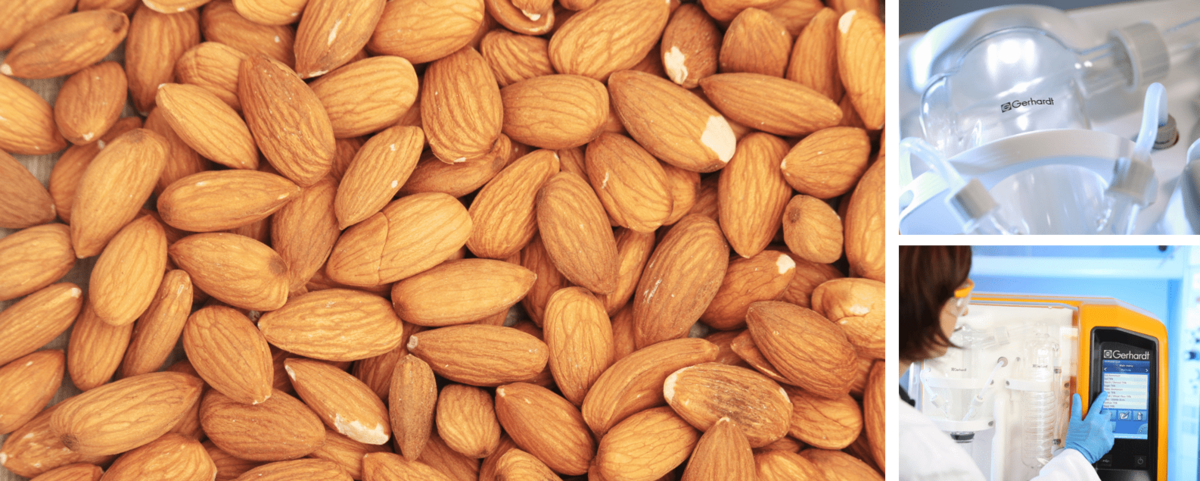Analysis of hydrogen cyanide in linseed, almonds & co: application requirements due to new maximum levels
Cyanogenic glycosides are chemical compounds that occur naturally in plant foods such as apricot kernels, bitter almonds and linseed. These foods are offered for direct consumption, but are also traditionally used for their flavoring properties in marzipan, persipan and related products. Prussic acid, also known as hydrogen cyanide, is released from these compounds during chewing and digestion. As hydrogen cyanide, like all cyanides, has a toxic effect, excessive consumption can lead to severe poisoning, which can even be fatal. The European Commission has therefore set limits for the hydrogen cyanide content in various foods. Regulation (EU) 2022/1364 amends Regulation (EC) No 1881/2006 with regard to the maximum levels for hydrogen cyanide in certain foodstuffs. The current maximum levels for hydrogen cyanide (including hydrocyanic acid bound in hydrocyanic acid glycosides) are as follows:
- 250 mg/kg for unprocessed whole, grated, ground, cracked or chopped linseed
- 150 mg/kg for unprocessed whole, grated, ground, cracked or chopped linseed placed on the market for final consumers
- 35 mg/kg for unprocessed whole, grated, ground, cracked or chopped almonds placed on the market for final consumers
- 20 mg/kg for unprocessed whole, grated, ground, cracked or chopped apricot kernels placed on the market for final consumers
- 50 mg/kg for cassava (cassava root), fresh & peeled
- 10 mg/kg for cassava flour and tapioca flour
Determination of hydrogen cyanide content using steam distillation
The method
When determining the hydrogen cyanide content, the sample is first slurried in water and incubated with
β-glucosidase from sweet almonds and incubated. The glycosidically bound hydrogen cyanide is digested. The sample is then placed in the VAPODEST, mixed with sodium acetate solution and distilled off in a steam stream. The distillate is collected in a defined volume of acidified silver nitrate solution, where it forms silver cyanide. The resulting silver thiocyanate is filtered off and the excess of unreacted silver nitrate is re-titrated with an ammonium thiocyanate solution.
- Application note: The results from the distillate produced can alternatively be determined using HPLC or CFA methods.
Sample preparation and weighing
The sample must be representative and homogeneous. Immediately before weighing, the sample is thoroughly mixed again by hand. Typical sample weights are between 0.5 g and 20 g, depending on the HCN content of the sample.
Enzymatic hydrolysis
Sample, ground sweet almonds and water are added to the flask. The flask is then sealed gas-tight with the rubber plug (C. Gerhardt cyanide plug) and incubated in the insert rack in a drying oven at 38 °C for at least 12 hours.
- Application note: The flask should be cooled to room temperature before the plug is removed.
Distillation
As soon as the samples have cooled down, the rubber plug is removed and the flask is immediately clamped in the VAPODEST. In the case of highly foaming samples, a few drops of antifoam solution can be added. The sample is automatically mixed with sodium acetate solution, followed by steam distillation. The condensate is introduced into the receiver by means of a suitable capillary directly into a 500 ml receiver vessel, which has been filled with the receiver of AgNO3 and HNO3. The amount of silver nitrate depends on the amount of hydrogen cyanide contained in the sample. The silver nitrate template should be added using a volumetric pipette, as this exact volume must be used for the calculation.
Titration
After completion of the distillation, the distillate is quantitatively transferred with distilled water via a folded filter into a dry volumetric flask with a capacity of 500 ml. The pleated filter is then rinsed with distilled water and the volumetric flask is filled up to the mark.
The titration is carried out with an aliquot (200 ml) of the filtrate obtained.
Blank value
To determine the blank value, the analysis (incubation + distillation + titration) is only carried out with the specified chemicals without a sample. If the blank test shows a consumption of silver nitrate solution, this is subtracted from the silver nitrate consumption of the main test.
Calculation
The HCN content can be calculated using the following equation:
1 ml silver nitrate solution, c = 0.02 mol/l, corresponds to 0.54 mg hydrogen cyanide (when using 200 ml filtrate).



![[Translate to English:] [Translate to English:]](/fileadmin/Redaktion/Freigestellte_Produktbilder/web_pic_vapodest_450x450px.jpg)